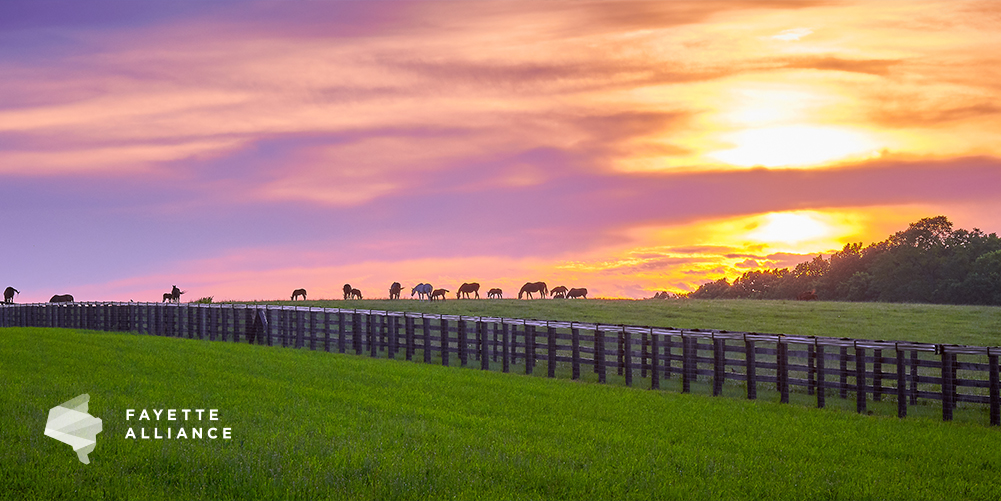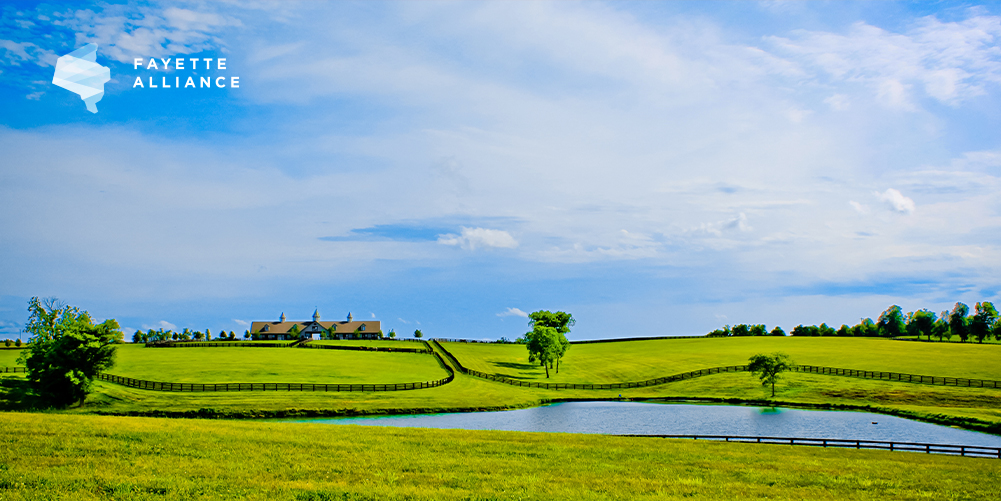Productive Rural Areas: Preserving What Makes Lexington Unique
Sustainable Lexington, one of the most visible results produced from the urban service boundary, exemplifies the unique character of the county and is one of the major draws for residents and tourists alike. This charm, this atmosphere—whatever you might call it—is centered on the natural environment around us and the abundance it produces for the residents of Lexington-Fayette County. This character is created by the distinctive and disparate urban and rural zones that are both formed and protected by the boundary. Infill redevelopment within the urban zone—smart growth, rather than expansion into our agricultural land—helps leave productive farmland unscathed within the USB. While many incentives within the boundary encourage smart growth, the Purchase of Development Rights is one effective tool to safeguard farmland with prime soils that contribute in so many ways to the unique character of our county.
The Value of Productive Rural Areas
The Bluegrass Region of Kentucky is known for its productive, legendary farmland, a natural result of the prime soils in Fayette County and the entire Central Kentucky region. These distinctive soils provide the foundation for the region’s noteworthy crops, horse farms, and nationally recognized bourbon industry. The soil here, formed on phosphatic limestone, is deep, residual soil with high levels of calcium and phosphorus, ingredients conducive to mineral-fortifying properties that help our plants and animals thrive. These productive rural areas infuse cash into the local economy. A few examples include:
- One out of every 12 jobs in the county is agriculturally based.
- Agriculture adds $2.3 billion annually to the local economy.
- Jobs supported by agriculture contribute $8.5 million to the local tax base.
The Bluegrass Region attracts tourists and top medical and educational talent for many of the agricultural interests found here, and many of the most famous attractions are situated in Fayette County. These rural areas entice visitors and talent who want to experience the equestrian, bourbon, brewing, or other agricultural industries nestled in our community. Spend the morning on a horse farm, an afternoon on a distillery tour, and an evening in our thriving downtown, all within a few miles of a Lexington bed and breakfast or boutique hotel. Kentucky recently realized over $3 billion annually in tourist dollars, and the tourist industry employs almost 95,000 Kentuckians. The Lexington-Fayette County local economy reaped a large percentage of that state-wide total. Fayette county recently earned over $2 billion from tourists, while creating over 15,000 jobs in Lexington alone. While tourism virtually disappeared during the pandemic, the most up-to-date data is encouraging! According to VisitLex, the top local draws for tourists include:
- Horse Farm Tours
- The Lexington Walk & Bluegrass Country Driving Tour
- Bourbon Distilleries
- Kentucky Horse Park
- Keeneland
From that list, it’s easy to see how those specific attractions benefit from the USB, and how preserving the unique character of our operational urban land is essential to maintaining a robust and thriving tourist-friendly economy within the county. Tourism can be a sustainable, family-wage earning industry that increases the awareness of visitors to our natural bounty. The top economy-driving industries in Lexington are agriculture, medical, and education and it’s tough finding top talent for these necessary industries. For example, UK Healthcare competes with top hospitals across the country for talent, so they ensure that they emphasize what makes Lexington stand out: our urban/rural balance. The foundation is here to leverage those qualities to generations of future visitors and residents alike, showcasing a central core of an urban experience based in Lexington, encircled by productive agricultural land.
Without stewardship in mind, unmitigated development of our productive rural areas would result in an unrecoverable loss of the nationally significant, prime soils that drive our signature industries. Thankfully, several protections, many formed by merged city-county governments, enable us to ensure that our distinctive rural areas are preserved for future generations.

What is the Purchase of Development Rights (PDR)?
Purchase of Development Rights at LFUCG, or PDR, is Kentucky’s first Agricultural Conservation Easement program developed and advocated by a local government, but it is not unique to Lexington, it’s a nationwide program.
The PDR program was founded as a result of the 1996 expansion of the USB in Fayette County; to balance opening up land for development with the preservation of our productive rural area. Through the PDR program, the Fayette County Rural Land Management Board can purchase development rights directly from farmers, preserving the farmland as a productive rural area in perpetuity. Some of the benefits of these rights include:
- Investment in rural areas
- Growth of the tourism economy
- Preservation of jobs created by farmland
- Continued financial incentives for agricultural industries
Through this voluntary program, 281 farms, both traditional and equine, have been permanently protected—an area of more than 30,500 acres, of the program’s 50,000-acre goal. It is easy to see that we must continue to implement the PDR program to safeguard Lexington’s productive rural land.
The program is funded mostly by state and national conservation programs, and LFUCG typically allocates $2M of the annual budget for PDR. Since PDR’s inception, LFUCG has contributed $38.4M while state and federal funds have brought in $41.5M.

Clearing Up Misconceptions About PDR
The Purchase of Development Rights can seem controversial. The concept is attention-grabbing, it’s the government purchasing private land for the sake of preserving farmland for generations to come, which is in line with balancing our thriving city with our productive farmland that makes Lexington unique. Some in our community may view the program as a case of wealthy land owners taking money from the city. On the contrary, under the Purchase of Development Rights program, farms, traditional and equine, must meet high standards for soil tests and meet many other requirements, then they are being given a comparatively small amount in exchange for giving up the right to ever sell their farmland, which would instead provide a huge profit. The goal is to conserve prime, productive farmland within the county’s extraordinary landscape, because it is an economy-driving industry that sets Lexington apart from any other mid-size city in the world.
Our USB was created in 1958 to manage development within Lexington-Fayette County. At the time, an urban growth boundary was a revolutionary concept, but the USB has become something of a landmark for planning across the nation. Picking up on the intent of the USB of taking positive action to ensure the community’s farmland is preserved from unmanaged suburban sprawl, the PDR was created in 1999 to protect 50,000 acres. Currently, it protects 30,000 acres through the program, so the PDR program is still growing. The $2 million a year that the city allocates is equally matched by federal dollars, so the expenses of operating the program are not fully carried by local budgets. Ultimately, what results is more productive rural areas in the county, with local farmers able to reinvest back into their operations with this mix of local and federal cash. These funds help farmers to:
- Finance necessary equipment purchases
- Invest in new crops
- Facilitate new agricultural infrastructure
Both residents and visitors to the county reap the rewards of these forward-thinking policies. When development efforts focus on infill redevelopment rather than expanding into rural land, agricultural industries continue to thrive. Profits, as well as the health of the land, are maintained. Growth within urban economic zones continues in a mindful and organized manner that benefits businesses as well as the community. The economic vitality of both urban and rural sectors leads to a perpetually sustainable Lexington-Fayette County.
Protection of our rural land is far from the only reason to support the ongoing maintenance of the USB. Take a look at 10 frequently asked questions about the Lexington urban service boundary to learn more about infill redevelopment and how the USB and smart growth preserve the character and economic sustainability of our unique region.

